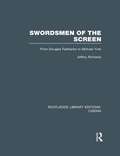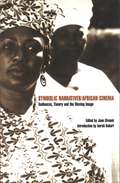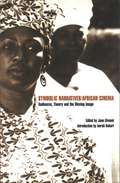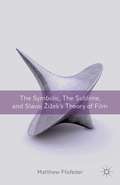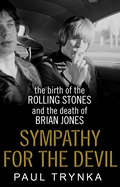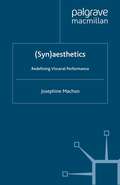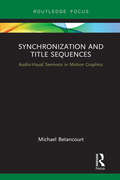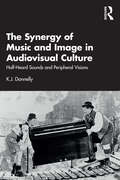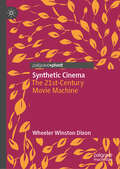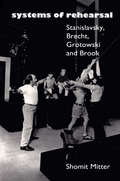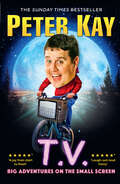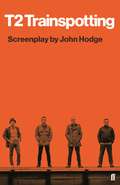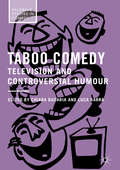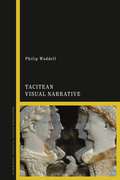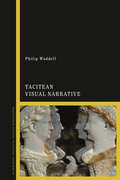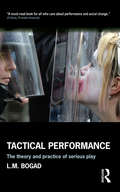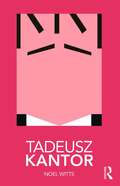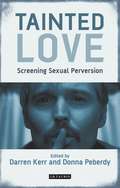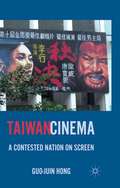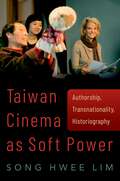- Table View
- List View
Swordsmen of the Screen: From Douglas Fairbanks to Michael York (Routledge Library Editions: Cinema)
by Jeffrey RichardsThis fascinating study of the genre of swashbuckling films received wide critical acclaim when it was first published in 1977. Jeffrey Richards assesses the contributions to the genre of directors, designers and fencing masters, as well as of the stars themselves, and devotes several chapters to the principal subjects if the swashbucklers – pirates, highwaymen, cavaliers and knights. The result is to recall, however fleetingly, the golden days of the silver screen. Reviews of the original edition: ‘An intelligent, scholarly, well-written account of adventure films, this work is sensitive both to cinema history and to the literary origins of the "swashbuckler"….Essential for any library with books on film, it may very well be the definitive book on its subject.’ – Library Journal
Symbolic Narratives/African Cinema: Audiences, Theory and the Moving Image
by June GivanniIn the conference Africa and the History of Cinematic Ideas held in London in 1995, film-makers, cultural theorists and critics gathered to debate a range of issues. Views were exchanged on such topics as imperialism, and the problems of distribution.
Symbolic Narratives/African Cinema: Audiences, Theory and the Moving Image
In the conference Africa and the History of Cinematic Ideas held in London in 1995, film-makers, cultural theorists and critics gathered to debate a range of issues. Views were exchanged on such topics as imperialism, and the problems of distribution.
The Symbolic, the Sublime, and Slavoj Zizek's Theory of Film
by M. FlisfederReturning to questions about ideology and subjectivity, Flisfeder argues that Slavoj Žižek's theory of film aims to re-politicize film studies and film theory, bringing cinema into the fold of twenty-first century politics.
Sympathy for the Devil: The Birth of the Rolling Stones and the Death of Brian Jones
by Paul TrynkaThe story of the Rolling Stones is one of the epic rock 'n' roll yarns of our time. Their music defined today's cultural landscape and their history is a source of endless fascination for music fans around the world. Yet one crucial part of that story has never been comprehensively analysed: the role of Brian Jones, the visionary who founded the band and controlled their early music down to the smallest detail.Drawing on over one hundred interviews with key principals including Keith Richards, Andrew Oldham and Marianne Faithfull, this is a story told from a totally new perspective and which lays bare the shocking ruthlessness, internal warfare and sexual competition within this most legendary of bands. As well as exploring Jones' crucial role in the Stones' music, it will also investigate the unravelling of his psyche, as observed by Brian's family, friends, bandmates, lovers and enemies. Victors get to write the history - but it's never wholly true. Brian's life story is a gripping one, an epic battle between creativity and ambition, between self-sabotage and betrayal. This book will disentangle the threads of the Rolling Stones story and put Brian Jones firmly in the foreground.
(Syn)aesthetics: Redefining Visceral Performance
by J. MachonA timely book that identifies the practice of '(syn)aesthetics' in artistic style and audience response, which helps to articulate the power of experiential practice in the arts. This exciting new approach includes interviews with leading practitioners in of theatre, dance, site-specific work, live art and technological performance practice.
Synchronization and Title Sequences: Audio-Visual Semiosis in Motion Graphics (Routledge Studies in Media Theory and Practice)
by Michael BetancourtSynchronization and Title Sequences proposes a semiotic analysis of the synchronization of image and sound in motion pictures using title sequences. Through detailed historical close readings of title designs that use either voice-over, an instrumental opening, or title song to organize their visuals—from Vertigo (1958) to The Player (1990) and X-Men: First Class (2011)—author Michael Betancourt develops a foundational framework for the critique and discussion of motion graphics’ use of synchronization and sound, as well as a theoretical description of how sound-image relationships develop on-screen.
Synchronization and Title Sequences: Audio-Visual Semiosis in Motion Graphics (Routledge Studies in Media Theory and Practice)
by Michael BetancourtSynchronization and Title Sequences proposes a semiotic analysis of the synchronization of image and sound in motion pictures using title sequences. Through detailed historical close readings of title designs that use either voice-over, an instrumental opening, or title song to organize their visuals—from Vertigo (1958) to The Player (1990) and X-Men: First Class (2011)—author Michael Betancourt develops a foundational framework for the critique and discussion of motion graphics’ use of synchronization and sound, as well as a theoretical description of how sound-image relationships develop on-screen.
The Synergy of Music and Image in Audiovisual Culture: Half-Heard Sounds and Peripheral Visions
by K.J. DonnellyThe Synergy of Music and Image in Audiovisual Culture: Half-Heard Sounds and Peripheral Visions asks what it means to understand music as part of an audiovisual whole, rather than separate components of music and film. Bringing together revised and updated essays on music in a variety of media – including film, television, and video games – this book explores the importance of partially perceived and registered auditory and visual elements and cultural context in creating unique audiovisual experiences. Critiquing traditional models of the film score, The Synergy of Music and Image in Audiovisual Culture enables readers across music, film, and cultural studies to approach and think about audiovisual culture in new ways.
The Synergy of Music and Image in Audiovisual Culture: Half-Heard Sounds and Peripheral Visions
by K.J. DonnellyThe Synergy of Music and Image in Audiovisual Culture: Half-Heard Sounds and Peripheral Visions asks what it means to understand music as part of an audiovisual whole, rather than separate components of music and film. Bringing together revised and updated essays on music in a variety of media – including film, television, and video games – this book explores the importance of partially perceived and registered auditory and visual elements and cultural context in creating unique audiovisual experiences. Critiquing traditional models of the film score, The Synergy of Music and Image in Audiovisual Culture enables readers across music, film, and cultural studies to approach and think about audiovisual culture in new ways.
Synthetic Cinema: The 21st-Century Movie Machine
by Wheeler Winston DixonIn this book, Wheeler Winston Dixon argues that 21st-century mainstream filmmaking is increasingly and troublingly dominated by "synthetic cinema." He details how movies over the last two decades have fundamentally abandoned traditional filmmaking values through the overwhelming use of computer generated imagery, digital touch ups for the actors, and extensive use of green screen technology that replace sets and location shooting. Combined with the shift to digital cinematography, as well as the rise of comic book and franchise cinema, the temptation to augment movies with lavish, computer generated spectacle has proven irresistible to both directors and audiences, to the point that, Dixon argues, 21st-century commercial cinema is so far removed from the real world that it has created a new era of flawless, fake movies.
Systems of Rehearsal: Stanislavsky, Brecht, Grotowski, and Brook
by Shomit MitterThe gap between theory and practice in rehearsal is wide. many actors and directors apply theories without fully understanding them, and most accounts of rehearsal techniques fail to put the methods in context. Systems of Rehearsal is the first systematic appraisal of the three principal paradigms in which virtually all theatre work is conducted today - those developed by Stanislavsky, Brecht and Grotowski. The author compares each system ot the work of the contemporary director who, says Mitter, is the Great Imitator of each of them: Peter Brook. The result is the most comprehensive introduction to modern theatre available.
Systems of Rehearsal: Stanislavsky, Brecht, Grotowski, and Brook
by Shomit MitterThe gap between theory and practice in rehearsal is wide. many actors and directors apply theories without fully understanding them, and most accounts of rehearsal techniques fail to put the methods in context. Systems of Rehearsal is the first systematic appraisal of the three principal paradigms in which virtually all theatre work is conducted today - those developed by Stanislavsky, Brecht and Grotowski. The author compares each system ot the work of the contemporary director who, says Mitter, is the Great Imitator of each of them: Peter Brook. The result is the most comprehensive introduction to modern theatre available.
T.V.: Big Adventures On The Small Screen
by Peter KayTHE INSTANT SUNDAY TIMES BESTSELLER *The long-awaited return of the comedy national treasure*
T2 Trainspotting
by John HodgeFirst there is an opportunity, then there is a betrayal.Twenty years have gone by.Much has changed but just as much remains the same.Mark Renton returns to the only place he can ever call home. They are waiting for him, of course: Spud, Sick Boy, and Frank Begbie. But they are not alone. Other old friends are waiting too: sorrow, loss, joy, vengeance, hatred, friendship, love, longing, fear, regret, diamorphine, self-destruction and mortal danger, they are all lined up to welcome him, ready to join the dance. Mark Renton returns, to the chaos of life and death.
Taboo Comedy: Television and Controversial Humour (Palgrave Studies in Comedy)
by Chiara Bucaria Luca BarraThe essays in this collection explore taboo and controversial humour in traditional scripted (sitcoms and other comedy series, animated series) and non-scripted forms (stand-up comedy, factual and reality shows, and advertising) both on cable and network television. Whilst the focus is predominantly on the US and UK, the contributors also address more general and global issues and different contexts of reception, in an attempt to look at this kind of comedy from different perspectives. Over the last few decades, taboo comedy has become a staple of television programming, thus raising issues concerning its functions and appropriateness, and making it an extremely relevant subject for those interested in how both humour and television work.
Tacitean Visual Narrative
by Philip WaddellCombining the studies of modern film, traditional narratology, and Roman art, this interdisciplinary work explores the complex and highly visual techniques of Tacitus' Annales. The volume opens with a discussion of current research in narratology, as applied to Roman historians. Narratology is a helpful and insightful tool, but is often inadequate to deal with specifically visual aspects of ancient narrative. In order to illuminate Tacitus' techniques, and to make them speak to modern readers, this book focuses on drawing and illustrating parallels between Tacitus' historiographical methods and modern film effects. Building on these premises, Waddell examines a wide array of Tacitus' visual narrative devices. Tacitean examples are discussed in light of their narrative effect and purpose in the Annales, as well as the ways in which they are similar to contemporary Roman art and modern film techniques, including focalization, alignment, use of the ambiguous gaze, temporal suggestion and quick-cutting. Through this approach the modern scholar gains a deeper understanding of the many ways in which Tacitus' Annales act upon the reader, and how his narrative technique helps to shape, guide, and deeply layer his history.
Tacitean Visual Narrative
by Philip WaddellCombining the studies of modern film, traditional narratology, and Roman art, this interdisciplinary work explores the complex and highly visual techniques of Tacitus' Annales. The volume opens with a discussion of current research in narratology, as applied to Roman historians. Narratology is a helpful and insightful tool, but is often inadequate to deal with specifically visual aspects of ancient narrative. In order to illuminate Tacitus' techniques, and to make them speak to modern readers, this book focuses on drawing and illustrating parallels between Tacitus' historiographical methods and modern film effects. Building on these premises, Waddell examines a wide array of Tacitus' visual narrative devices. Tacitean examples are discussed in light of their narrative effect and purpose in the Annales, as well as the ways in which they are similar to contemporary Roman art and modern film techniques, including focalization, alignment, use of the ambiguous gaze, temporal suggestion and quick-cutting. Through this approach the modern scholar gains a deeper understanding of the many ways in which Tacitus' Annales act upon the reader, and how his narrative technique helps to shape, guide, and deeply layer his history.
Tactical Performance: Serious Play and Social Movements
by Larry BogadTactical Performance tells fun, mischievous stories of underdogs speaking mirth to power - through creative, targeted activist performance in the streets of cities around the world. This compelling, inspiring book also provides the first ever full-length practical and theoretical guide to this work. L.M.Bogad, one of the most prolific practitioners and scholars of this genre, shares the most effective non-violent tactics and theatrics employed by groups which have captured the public imagination in recent years. Tactical Performance explores carnivalesque protest in unique depth, looking at the possibilities for direct action and sometimes shocking confrontation with some of the most powerful institutions in the world. It is essential reading for anyone interested in creative pranksterism and the global justice movement.
Tactical Performance: Serious Play and Social Movements
by Larry BogadTactical Performance tells fun, mischievous stories of underdogs speaking mirth to power - through creative, targeted activist performance in the streets of cities around the world. This compelling, inspiring book also provides the first ever full-length practical and theoretical guide to this work. L.M.Bogad, one of the most prolific practitioners and scholars of this genre, shares the most effective non-violent tactics and theatrics employed by groups which have captured the public imagination in recent years. Tactical Performance explores carnivalesque protest in unique depth, looking at the possibilities for direct action and sometimes shocking confrontation with some of the most powerful institutions in the world. It is essential reading for anyone interested in creative pranksterism and the global justice movement.
Tadeusz Kantor (Routledge Performance Practitioners)
by Noel WittsTadeusz Kantor – a theoretician, director, innovator and painter famed for his very visual theatre style – was a key figure in European avant-garde theatre. He was also known for his challenging theatrical innovations, such as extending stages and the combination of mannequins with living actors. The book combines: a detailed study of the historical context of Kantor’s work an exploration of Kantor’s own writings on his theatrical craft a stylistic analysis of the key works, including The Dead Class and Let the Artists Die, and their critical reception an examination of the practical exercises devised by Kantor. As a first step towards critical understanding, and as an initial exploration before going on to further, primary research, Routledge Performance Practitioners offer unbeatable value for today’s student.
Tadeusz Kantor (Routledge Performance Practitioners)
by Noel WittsTadeusz Kantor – a theoretician, director, innovator and painter famed for his very visual theatre style – was a key figure in European avant-garde theatre. He was also known for his challenging theatrical innovations, such as extending stages and the combination of mannequins with living actors. The book combines: a detailed study of the historical context of Kantor’s work an exploration of Kantor’s own writings on his theatrical craft a stylistic analysis of the key works, including The Dead Class and Let the Artists Die, and their critical reception an examination of the practical exercises devised by Kantor. As a first step towards critical understanding, and as an initial exploration before going on to further, primary research, Routledge Performance Practitioners offer unbeatable value for today’s student.
Tainted Love: Screening Sexual Perversion (International Library of the Moving Image (PDF))
by Donna Peberdy Darren KerrThis is the first critical anthology to offer extended analysis of the representation of sexual perversion on screen. Interrogating the recent shift towards the mainstream in the cinematic representation of previously marginalised sexual practices, Tainted Love challenges the discourses and debates around sexual taboo, moral panics, degeneracy, deviance and disease, which present those who enact such sexualities as modern folk devils. This timely collection brings together leading scholars who draw on a variety of critical approaches including adaptation, performance, cultural studies, queer theory, feminism and philosophy to examine screen representations of controversial sexualities from the weird and wonderful to the debased and debauched. Chapters explore provocative performances of hysteria and sexual obsession, 'everyday' perversion in neoliberal culture, the radical potential of sadomasochism, adolescent sexuality in the films of Larry Clark, intergenerational sex and incestuous relations in French cinema, sexual obsession in gay cinema, the straightness of necrophilia, the presentation of the paedophile, Swedish Erotica's 'good sex' and re-imagining the Marquis de Sade from film to slash fiction. In order to move past binary distinctions of good and bad, normal and abnormal, moral and immoral, Tainted Love seeks to critically interrogate perverse sexualities and sexual perversion on screen.
Taiwan Cinema: A Contested Nation on Screen
by G. HongA groundbreaking study of Taiwan cinema, Hong provides helpful insight into how it is taught and studied by taking into account not only the auteurs of New Taiwan Cinema, but also the history of popular genre films before the 1980s. The book is essential for students and scholars of Taiwan, film and visual studies, and East Asian cultural history.
Taiwan Cinema as Soft Power: Authorship, Transnationality, Historiography
by Song Hwee LimWhy has Taiwanese film been so appealing to film directors, critics, and audiences across the world? This book argues that because Taiwan is a nation without hard political and economic power, cinema becomes a form of soft power tool that Taiwan uses to attract global attention, to gain support, and to build allies. Author Song Hwee Lim shows how this goal has been achieved by Taiwanese directors whose films win the hearts and minds of foreign audiences to make Taiwan a major force in world cinema. The book maps Taiwan's cinematic output in the twenty-first century through the three keywords in the book's subtitle-authorship, transnationality, historiography. Its object of analysis is the legacy of Taiwan New Cinema, a movement that begun in the early 1980s that has had a lasting impact upon filmmakers and cinephiles worldwide for nearly forty years. By examining case studies that include Hou Hsiao-hsien, Ang Lee, and Tsai Ming-liang, this book suggests that authorship is central to Taiwan cinema's ability to transcend borders to the extent that the historiographical writing of Taiwan cinema has to be reimagined. It also looks at the scaling down of soft power from the global to the regional via a cultural imaginary called "little freshness", which describes films and cultural products from Taiwan that have become hugely popular in China and Hong Kong. In presenting Taiwan cinema's significance as a case of a small nation with enormous soft power, this book hopes to recast the terms and stakes of both cinema studies and soft power studies in academia.
